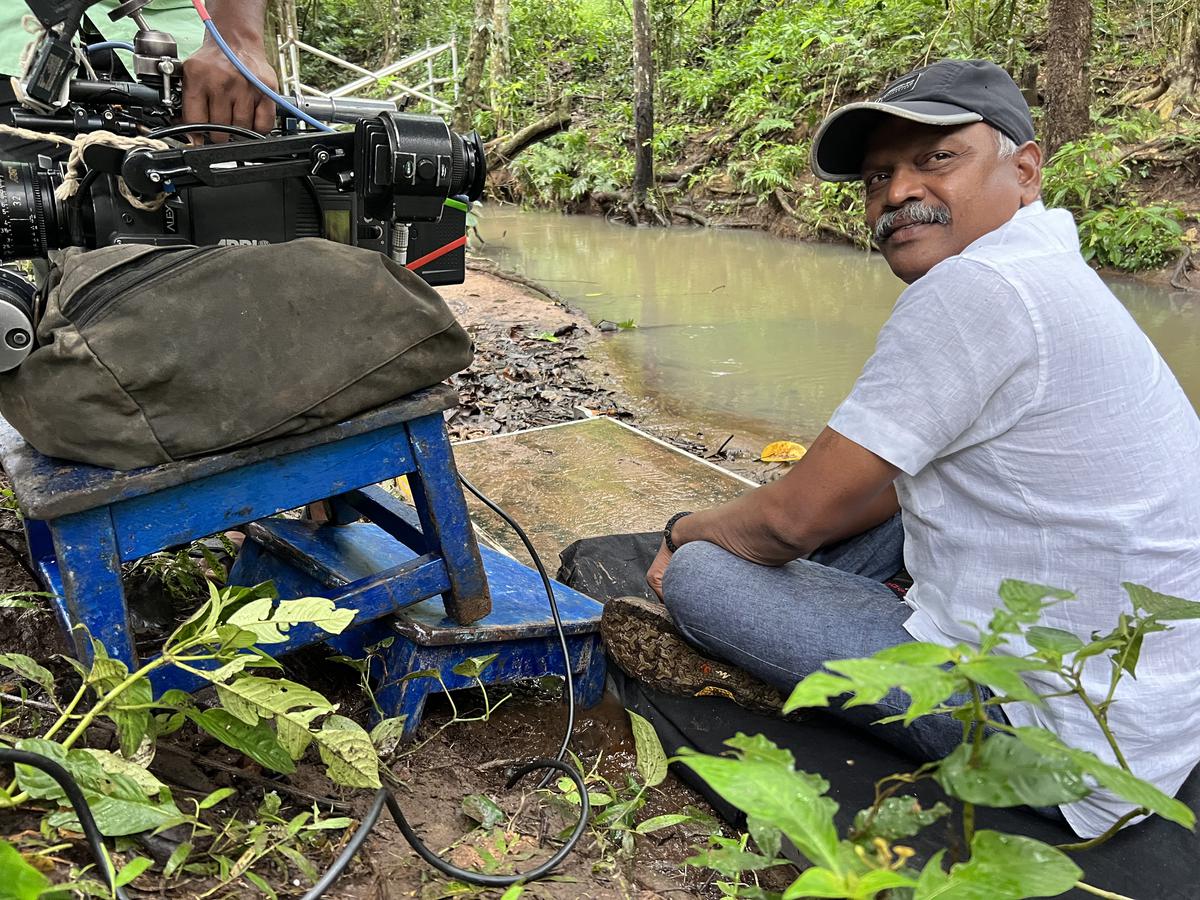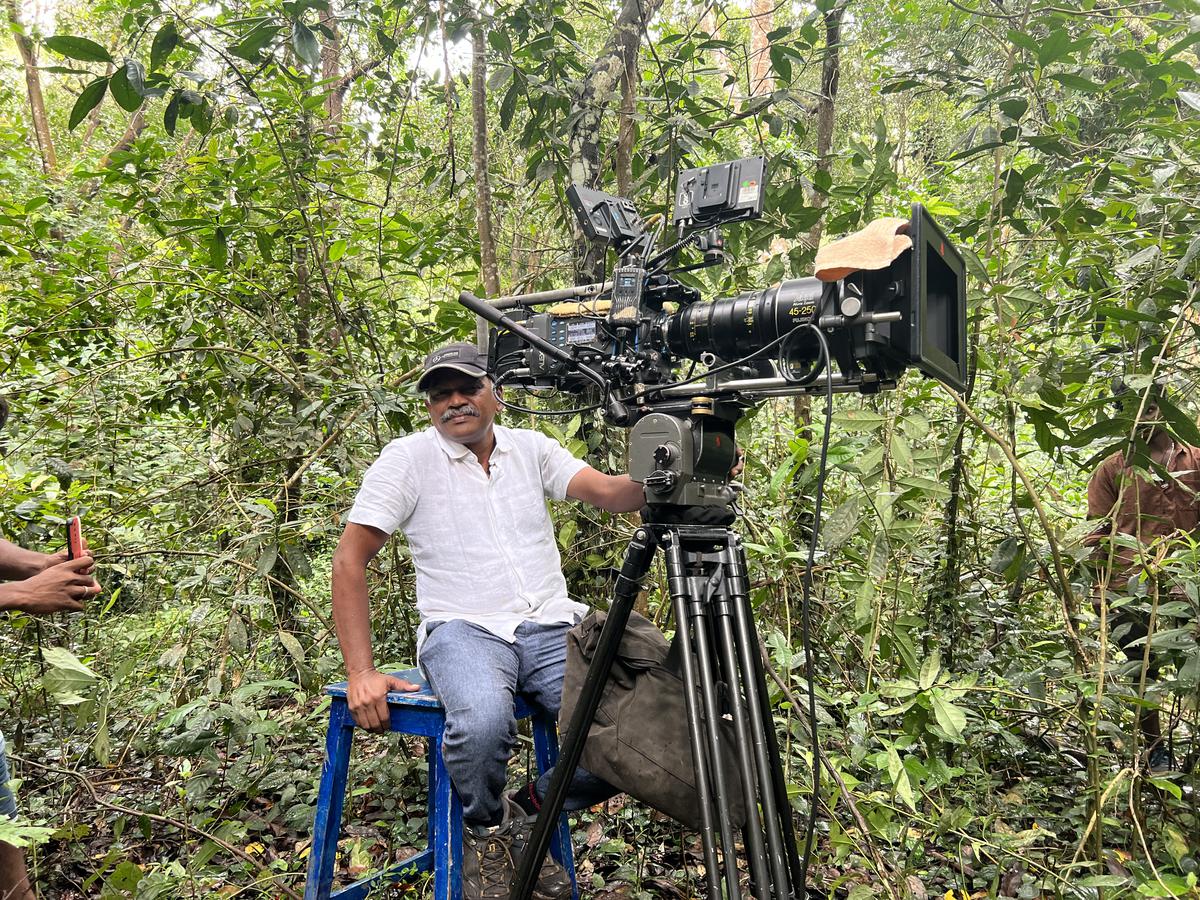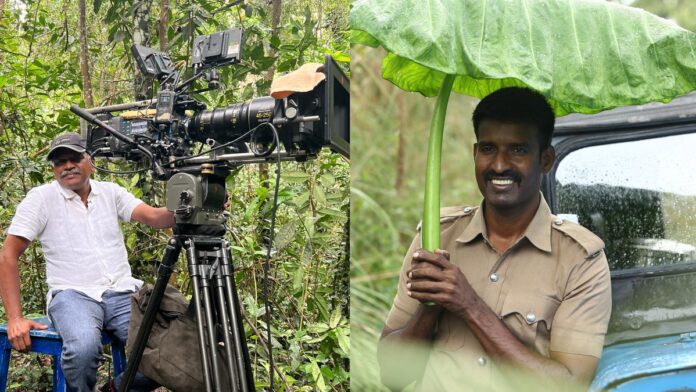
Velraj at the sets of ‘Viduthalai’ and Soori in a still from the film
| Photo Credit: Special Arrangement
This year, cinematographer R Velraj, who made his debut with the Hindi film Supari in 2003, completes 20 years in the industry. “I owe it to the blessings of the Almighty without which I couldn’t be here, working with such directors on such big films,” says Velraj, who is elated to have started this landmark year with Viduthalai Part 1.The film, which marks Velraj’s fifth collaboration with director Vetri Maaran, has been praised for its cinematography and the cameraman explains in detail the lengths they have gone to bring their filmmaker’s dream to celluloid.
How challenging was it to shoot Viduthalai?
When Viduthalai Part 1 started, the first shot (involving a train accident) wasn’t there as it was a small-budget film. But when Vijay Sethupathi sir came in, we got to do it. We first decided to shoot at the Sathyamangalam forests but as they were reserve forests and we had scenes to be shot even at night, we chose private forests in Kadambur. That doesn’t mean it’s easily accessible as only 4-wheel drive-enabled pick-up trucks can go up the rough terrain. The routes were so treacherous that the village had only four drivers who could manoeuvre the narrow roads where one wrong move can result in plummeting down the cliff. On roads where the risk was less, Soori drove the jeep but for difficult roads, stunt master Peter Hein devised a jeep that could have Soori in the driver’s seat and still be operated by a stuntman. Every day at the shoot, we would walk anywhere between 7-14 kilometres. Today, the film’s cinematography is much spoken about because of the lengths we went to.
The single-shot train sequence that the film starts with feels like a gargantuan task technically. Can you tell us how you went about it?
The eight-minute train sequence, in total, cost Rs 8-10 crore and took three months for the set to come up. The bridge and tracks on them are so well-made that a train can go over them. We bought two train compartments and built four of them. Some had to look toppled while some were just derailed on the tracks. There were practical difficulties because the shot involved one of the compartments falling from the bridge mid-shot. For that, we had to strike a balance with the weight.
The sequence involved the use of a gimbal and multiple technicians carrying it. It starts with one of them sitting on top of the minister’s car who arrives at the scene and it goes through the compartments only to end with one of them getting attached to a crane for the final top shot. Many of Vetri sir’s previous assistants who have become directors now had come to assist him with this sequence. Some of the extras who we had trained did not show up for the shoot and we had to train new people from scratch. The gimbal worked remotely with the MIMIC Control System which was handled by another person who would handle the camera tilting. Mobile phone signals would interrupt the Bluetooth connection between the systems, so we had to make sure every extra had put their phone on flight mode. A small mishap means we would have to start all over again and it takes three hours to set everything up. The art department pulled off a tremendous feat and the credit should go to the producer for agreeing to such a sequence.

Velraj at the sets of ‘Viduthalai’
| Photo Credit:
Special Arrangement
The film had a lot of wide-angle shots…
Yes, it was one of the many technical decisions we took along with how we decided to not show the forest to be lush and green. We decided on a colour palette and working in an environment like a forest is difficult for which we used CGI. Right at the pre-production stage, we decided on the lens and equipment. We used steady cams, gimbals and even a technician from abroad who could use a gimbal while being on rollerskates. The narrow town sequences had a lot of characters running around and we couldn’t keep up with their pace with cameras mounted on us, so we had to use rollerskates. Every scene was shot with four cameras with one being a wide shot and another being a Helicam.
It was also a creative decision from Vetri sir to not shoot when there was sunshine. We had to even stop the shoot many times to wait for it to subside and for the mist to cover the location. Ironically, we couldn’t shoot while it was raining too, to help maintain the mood throughout the film.
The film also involved torture sequences. How difficult was it to shoot them?
The sequences where the women are stripped obviously had the actors wearing body-coloured clothes. Such sequences are the only way in which we can show the pain the people endured. Dialogues or voiceovers wouldn’t create the impact the scenes did. From a technical perspective, those scenes were intentionally shot with minimal light. We wanted to shoot in a manner where the message is implied.

Velraj at the sets of ‘Viduthalai’
| Photo Credit:
Special Arrangement
We heard that the night shots weren’t shot at day and converted. With the technology being available today, wasn’t it easier to do so given the difficult terrain you worked in?
That technology has been there for a while now and was even used in Virumaandi (2004). It’s because back then, they didn’t have the facilities to shoot at night. Today, we have cameras, lights and lenses with the right exposures. Using the day-for-night technique, we could’ve shown the forest to be brighter but it wouldn’t have given the effect the film has now. Five years ago, placing lights while working on hills would’ve been a near-impossible task. But today, we’ve got access to smaller lights that can be clamped to treetops. Doing that would make the light source apparent, so the trick is to make sure it isn’t visible. The villagers helped us by climbing the tall trees to tie the lights. When Ilaiyaraaja sir composed the ‘Onnoda Nadandhaa’ track, we decided to shoot this using the night effect. We shot the song and showed him the visuals which he was impressed by and he even enhanced the track.
When a film is being made with a certain ideology, is it necessary for a technician to also be on the same page as far as politics is concerned?
Not necessarily but Vetri sir expects us to understand the film’s politics completely. With Asuran and Viduthalai, he has attempted to showcase the pain of the commoner and the politics behind it and has also succeeded in it. Turning an artsy subject into a commercial film isn’t easy and I doubt any other director would have as much success at it.
#Viduthalai #Part #cinematographer #Velraj #Vetri #Maaran #expects #technicians #understand #films #politics
